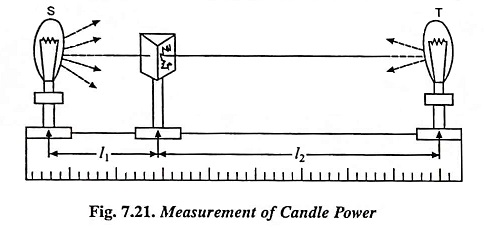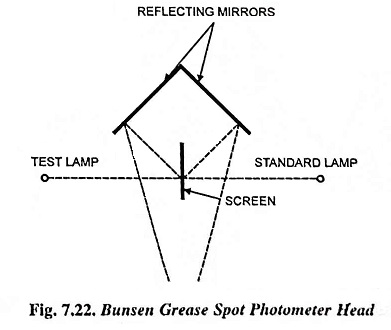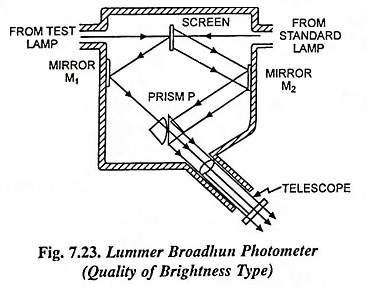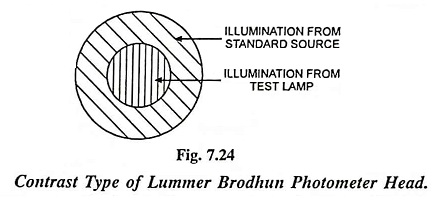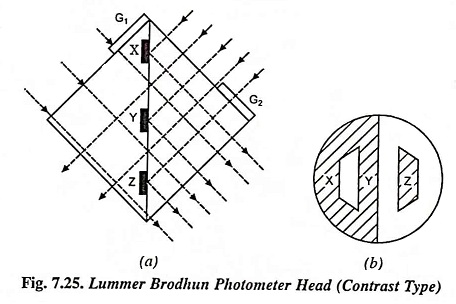What is a Photometer and Photometry? – Working Principle and Types:
The candle power of a source in any given direction is measured by comparison with a standard or substandard source employing photometer bench and some form of photometer. The experiment is performed in a dark room with dead black walls and ceiling in order to eliminate errors due to reflected light.
The photometer bench consists essentially of two steel rods which carry the stands or saddles for holding the two sources, the carriage for the photometer head and for any other apparatus employed in making measurements. One of the bar carries a bar strip, graduated in centimetres and millimetres. The carriages which slides upon the bench have except that carrying the photometer head, a circular table which can be rotated in a horizontal plane and clamped in any position. The circular table is provided with a scale graduated in degrees round its edge so that the angle of rotation of lamp from the direction of the axis of bench can be measured. The bench should be rigid so that the source being compared may be free from vibrations and the carriage holding the photometer head should be capable of moving smoothly and with very little effort. The photometer head acts as a screen for comparison of illumination of the standard source and the source under test. There are different types of photometers, which can be used for the purpose. Some of them will be described here.
The principle of most of the methods of measurement is based upon the Inverse Square Law.
The standard source, whose candle power is known (say S) and the source under test whose candle power is to be determined, are set on the bench at a distance apart with some type of screen in line with, and between, them, as shown in Fig. 7.21. The photometer head or screen is moved in between the two fixed sources until the illumination on both sides of the screen is same. If the distances of the standard source S and source under test T from photometer head are l1 and l2 respectively then according to inverse square law
Since the square of distances are involved in measurement, distances should be measured accurately. In order to obtain distance exactly two points are determined at which there is a perceptible difference in illumination from the two sides and the point half way between them is then taken as the position of equal illumination.
Most of the photometer heads consist of some device by means of which the illumination of two surfaces, side by side—one illuminated by standard source and other by the source whose candle power is to be determined may be compared under exactly similar conditions without movement of the eye. The photometers which are most common in use are the Bunsen and the Lummer Brodhun photometers. These photometers are best for use if the sources to be compared give light of same or approximately similar colours. In case the light from the two sources to be compared differ in colour, a Flicker photometer is best suited.
Bunsen Grease Spot Photometer:
It consists of a piece of tissue paper with grease spot in the centre, held vertically in a carrier between the two light sources to be compared. The position of the carrier is then adjusted until the semi-transparent spot and the opaque parts of the paper are equally bright, i.e., the grease spot is invisible. The distances of the tissue paper from both light sources are measured. The candle power of the source under test is then determined from the relation.
The Bunsen Grease spot photometer can be used in other way also. In this method of use, the photometer is fixed at one position and one side of the paper is illuminated first by test lamp and then by a standard lamp and distance of the lamp from the photometer head is measured in each case on disappearing of grease spot.
If l1 and l2 are the distances then the candle power of source under test
The simplest and best method of use of Bunsen Grease spot photometer for comparison of illumination on either side of the screen is to use two mirrors placed behind the paper and view the illumination on both the sides through the mirrors simultaneously by standing in a plane passing through the photometer head and perpendicular to the lines joining the lamps. The position of the photometer head for equal contrast in illumination between the opaque and transparent portions of the paper on the two sides is determined. Now the candle power of the lamp under test can be calculated as before.
There are two types of Lummer Brodhun heads—one is the equality of brightness type and second is the contrast type. Contrast type is more accurate and, therefore, more used in photometric measurements.
Equality of Brightness Type Photometer Head:
The photometer head consists of a plaster of paris screen, two mirrors M1 and M2, a compound prism P and a telescope. The compound prism is made up of two right angled glass prisms, one of which has principal surface as spherical one with a small flat portion at the centre. This small flat portion at the centre makes optical contact with the flat surface of the other prism, as shown in Fig. 7.23.
Each side of the screen S is illuminated by light entering from one of the sources to be compared. The light rays coming from the test lamp and standard lamp are reflected by the screen on to the mirrors M1 and M2 respectively which in turn reflects the same to the compound prism P. Only that portion of light reflected by mirror M1 which falls on the flat surface of the spherical prism, passes straight into the telescope while the rest of it is reflected back. The portion of light reflected by mirror M2, which falls on the surface of contact between the two prism passes straight through the compound prism while the rest of it is reflected through the telescope. Thus the observer sees the centre portion of the circular area illuminated by the test lamp and outer ring illuminated by the standard lamp.
While carrying out measurements, the photometer head is moved until the dividing line between the centre portion and surrounding disappears. The disappearance of this dividing line indicates the equality of brightness. Now the distance of the photometer head from the two lamps is noted and the candle power of lamp under test can be calculated by using inverse square law principle.
Contrast Type of Lummer Brodhun Photometer Head:
The compound prism, in the contrast type photometer head, is made up of right angled prisms with their principal surfaces face to face. One of the prism [the left hand one in Fig. 7.25 (a)] has its hypotenuses surface etched away at X, Y and Z so that it forms a pattern similar to that shown in the figure.
The light falling on the compound prism from both sides of the screen will pass through the un-etched portions of the prism at the junction but will be reflected by the etched surfaces. The etched portion will have difference in illumination as compared with the un-etched portion in case the illumination of the surfaces of reflections are different, as shown in Fig. 7.25 (b). G1 and G2 are two glass plates which give a little reflected light in order to maintain some difference between illumination of the etched and un-etched areas for all the positions of the photometer head. The difference is about 8% in balance position of photometer head. The photometer head will be in balance position when the difference in illumination of etched and the un-etched portions will be same on each half of the circular area. In case the balance position is disturbed, the difference in illumination of area Z and its surrounding area will decrease while the difference in illumination of area XY and the inner trapezium will increase. The photometer head is moved until the equal contrast is obtained. This type of head gives accuracy within 1% when lights of similar colours are compared.
Flicker Photometers:
These photometers are employed when the two sources giving light of different colours are to be compared. The working of these photometers depend upon the fact that if two illuminated surfaces are presented to the eye with rapid alternations, the flicker disappears when the surfaces are of equal brightness. These photometers are not affected by the difference in colour of two lights to be compared as much as photometers of the steady comparison type are affected since the colour difference between two alternating fields of light disappears at a lower speed of alternation than the speed at which difference in brightness disappears. The speed of alternation should be kept as low as possible at which the disappearance of the flicker can be obtained for the small variation in brightness.
